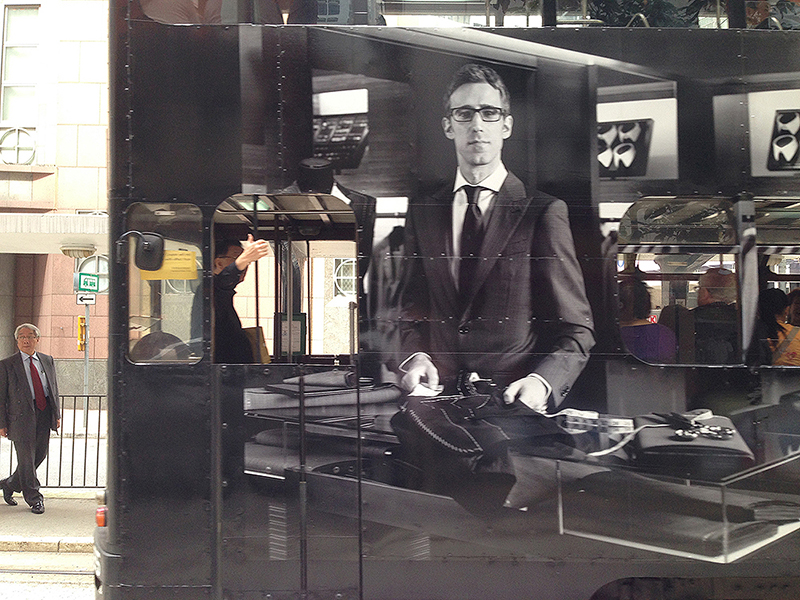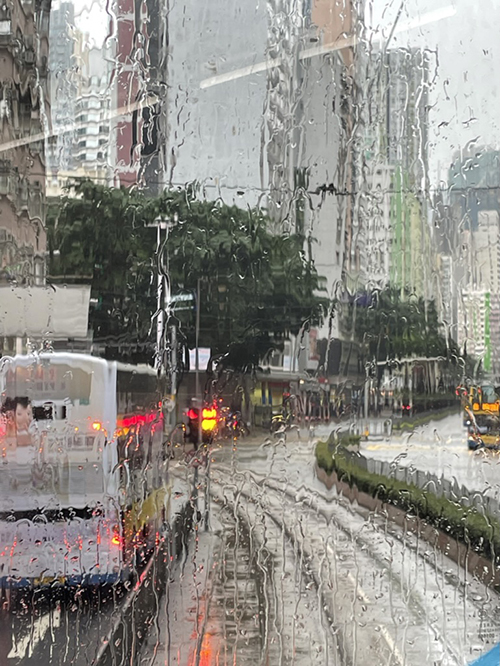
Hong Kong trams, a way to travel. When strolling in Hong Kong, it barely takes a moment to encounter one of the iconic trams that travel up and down the island’s northern coastline along the main arteries of Des Voeux, Queensway, and Hennessy Roads.
While ubiquitous for the observer, their presence is most noticeable in Central District as trams confront unruly pedestrians (most wearing tailored British suits), or when negotiating the sharp S turn in front of the neoclassical Court of Final Appeal next to Chater Garden. You cannot miss the insistent ringing of the trams with their familiar “ding ding” chime. This auditory jingle is a stern warning for strollers to move promptly out of the way as skilled tram drivers keep up with the pace of the bustling city!

The two-story trams were introduced in 1912, although the original one story trams debuted in 1904. While the swift moving trams might seem menacing, they are fondly referred to as “Ding Ding.” Tall and slender, with an undeniable visual capacity to impress, they are moving billboards that often blur the outside commercial messaging with profiles of inside traveling passengers.

I love taking the trams at any hour of the day and spend whatever time it takes to go nowhere, a perfect pastime to explore my favorite Asian city. From Kennedy Town at the far west side of the island to Causeway Bay at the eastern side, my journey unfolds through layers of the city’s history and cultural transformations.

Traveling the traditional neighborhoods of Sai Ying Pun and Sheung Wan that showcase endless mom and pop shops spilling onto the sidewalk, passing the traditional inside street markets, heading through the frenetic business district of Central with its unforgettable mid-level escalator, then racing straight through Admiralty and the luxury shopping malls and eye-catching skyscrapers all linked to a network of raised pedestrian walkways—yes, the tram can reach a speed of 45 miles an hour—and ending up in Wan Chai and the newly hip neighborhood of Causeway Bay, the journey via tram is a visual treat that almost beats tea at the Peninsula!

For me, riding the tram daytime or evening offers shifting perspectives and panoramic views of how the city works. Over the years, I have come to recognize the spots that make my Hong Kong so memorable. These, I will confess, are often linked to shopping, studying buildings, art visits, postcard-like shots, and eateries such as bakeries and dim sum places where I may enjoy a cornucopia of my favorite dishes.
Inside the Tram

Experiencing the island by tram is unforgettable. As one boards at the rear—pay as you leave at the front—I recommend you dash up the steep steeps to anchor yourself in one of the last available window seats. Now, your visual journey through Hong Kong starts. It is amazing to travel through this dense city and see it from this perspective. Everything inside is narrow, spatially tight in the corridor-like space, with little room for social distancing. Don’t forget, you are in Hong Kong with its 7.5 million inhabitants!
Any claustrophobia is immediately counterbalanced by the cinematic views that unfold as the tram moves from station to station. The urban cityscape is fascinating to experience from this elevation, and views of pedestrians, stores, and buildings of any height could make you dizzy with interest. Where to look is up to you.

Some of the best moments are when you encounter other modes of transportation, such as the British inspired double-deckers, that snake around at accelerated speed. Often, when sharing a moment of standstill due to traffic congestion, one can easily lower the window and touch a passenger in the opposite bus. In the evening, I love to see passengers exhausted from one more frenetic day, phones no longer in hand, dozing away until their final destination; often as far as on the mainland’s New Territories near the Chinese border.

If you have a moment during your journey, take time to admire the details within the tram cars. Everywhere you will find common sense design. From the nosing on each step to the connections between chromed handrails, and the opening mechanisms of the windows offering traditional natural ventilation, the details are a delight. Everything seems ready to hold and assist the passenger as they dream of making more money. Perhaps perfect Feng Shui. What amazes me is that the aesthetic meets the hand and feet exactly where needed. Spaces are tight (inside 6ft 6in), and movements are calculated to move easily through space with no afterthought.

The experienced rider will know at a glance the era of the tram they have boarded. The clues are in the materials – wood versus metal, the shift to more ergonomic shapes, the spatial continuity of handrails, and more (Image 7, 8, and 9).


Conclusion

With a robust subway system (MTR) serving the entire city, along with the British inspired double-decker buses, hordes of red taxis, and the equally memorable Star Ferry shuttling between Hong Kong island and the mainland (another blog in the making), the Hong Kong trams are unique to the island and remain an iconic form of transportation with which to discover the city. Their charm and historic significance remain part of the experience of being in Hong Kong. There is not a day when I am there that I do not fondly admire them, listen to them, and most importantly, step on to become lost in this magic city.
Additional blogs pertaining to Hong Kong
Murals at Hong Kong Central station
Hong Kong Shopping Mall
Hong Kong: Bauhaus style Central Market
Hong Kong: a lesson in stairs (Central Market)
Hong Kong: the history of Central Market
Bathroom at the Novotel in Hong Kong
Hong Kong: a lesson in stairs (Billie Tsien and Tod Williams)